Note: This was originally published in late June, with a plan to include specific books that discussed the science of urban ecology. I’ve added a few titles in this realm to the original post on 7/7 and organized them alphabetically with a summary at the beginning.
The literature of the somewhat youthful discipline of urban ecology contains a relatively small number of books, at least for now. I’m compiling resources on a number of topics, starting with specific topics of Urban Ecology, but will be adding more on some related ideas such as Landscape Ecology, Ecological Urbanism, as well as more historical titles from the Design Canon. This initial list below is a start, with some summaries for a bit of context.
If you know of others to add let me know!
URBAN ECOLOGY
Advances in Urban Ecology: Integrating Humans and Ecological Processes in Urban Ecosystems Marina Alberti, Springer, December 2008.
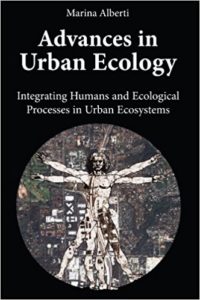 The future of Earth’s ecosystems is increasingly influenced by the pace and patterns of urbanization. One of the greatest challenges for natural and social scientists is to understand how urbanizing regions evolve through the complex interactions between humans and ecological processes. Questions and methods of inquiry specific to our traditional disciplinary domains yield partial views that reflect different epistemologies and understandings of the world. In order to achieve the level of synthesis required to see the urban ecosystem as a whole we must change the way we pose questions and search for answers.
The future of Earth’s ecosystems is increasingly influenced by the pace and patterns of urbanization. One of the greatest challenges for natural and social scientists is to understand how urbanizing regions evolve through the complex interactions between humans and ecological processes. Questions and methods of inquiry specific to our traditional disciplinary domains yield partial views that reflect different epistemologies and understandings of the world. In order to achieve the level of synthesis required to see the urban ecosystem as a whole we must change the way we pose questions and search for answers.
Cities are the result of human and ecological processes occurring simultaneously in time and in space and the legacy of the simultaneous processes of the past. Urban ecology is the study of the co-evolution of human-ecological systems. Scholars of both urban systems and ecology must challenge the assumptions and world views within their disciplines and work towards a hybrid theory that builds on multiple world views.
The synthesis of research findings provided in this book is a first step towards articulating the challenge for scholars of urban ecosystems; it leads the way toward the integration we must achieve if we are to better understand and solve emerging issues in urban ecosystems.
Ecology of Urban Environments, Kirsten M. Paris. Wiley-Blackwell, May 2016.
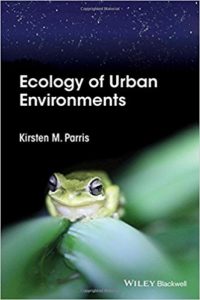 Urban environments are expanding globally as the number and proportion of humans that live in cities continues to increase. The discipline of urban ecology is also expanding as interest surges in the ecological impacts of urbanization and the diverse ways in which urban environments can affect their human and non-human residents.
Urban environments are expanding globally as the number and proportion of humans that live in cities continues to increase. The discipline of urban ecology is also expanding as interest surges in the ecological impacts of urbanization and the diverse ways in which urban environments can affect their human and non-human residents.
This book provides an accessible introduction to urban ecology, using established ecological theory to identify generalities in the complexity of urban environments. Engaging yet scholarly, it examines the biophysical processes of urbanization and how these work together to influence (a) the characteristics of urban environments in developed and developing countries, and (b) the dynamics of urban populations, communities and ecosystems. With a strong international focus, it also explores the ecology of humans in cities and discusses practical strategies for conserving biodiveristy and maintaining ecosystem services in urban environments. Finally, it argues that existing ecological theory is appropriate for understanding the ecology of urban environments across all levels of organization, from individual organisms to entire ecosystems; effective science and management need not wait on a new theory of urban ecology.
The Routledge Handbook of Urban Ecology, Ian Douglas, David Goode, Mike Houck, Rusong Wang. Routledge, March 2015.
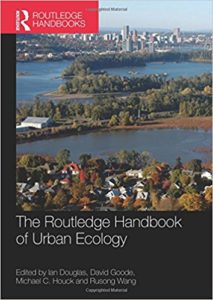 The birds, animals, insects, trees and plants encountered by the majority of the world’s people are those that survive in, adapt to, or are introduced to, urban areas. Some of these organisms give great pleasure; others invade, colonise and occupy neglected and hidden areas such as derelict land and sewers. Urban areas have a high biodiversity and nature within cities provides many ecosystem services including cooling the urban area, reducing urban flood risk, filtering pollutants, supplying food, and providing accessible recreation. Yet, protecting urban nature faces competition from other urban land uses.
The birds, animals, insects, trees and plants encountered by the majority of the world’s people are those that survive in, adapt to, or are introduced to, urban areas. Some of these organisms give great pleasure; others invade, colonise and occupy neglected and hidden areas such as derelict land and sewers. Urban areas have a high biodiversity and nature within cities provides many ecosystem services including cooling the urban area, reducing urban flood risk, filtering pollutants, supplying food, and providing accessible recreation. Yet, protecting urban nature faces competition from other urban land uses.
The Handbook of Urban Ecology analyses this biodiversity and complexity and provides the science to guide policy and management to make cities more attractive, more enjoyable, and better for our own health and that of the planet. This Handbook contains 50 interdisciplinary contributions from leading academics and practitioners from across the world to provide an in-depth coverage of the main elements of practical urban ecology. It is divided into six parts, dealing with the philosophies, concepts and history of urban ecology; followed by consideration of the biophysical character of the urban environment and the diverse habitats found within it. It then examines human relationships with urban nature, the health, economic and environmental benefits of urban ecology before discussing the methods used in urban ecology and ways of putting the science into practice.
The Handbook offers a state-of the art guide to the science, practice and value of urban ecology. The engaging contributions provide students and practitioners with the wealth of interdisciplinary information needed to manage the biota and green landscapes in urban areas.
Urban Ecology: An Introduction, 1st edition. Ian Douglas & Philip James. Routledge, January 2015.
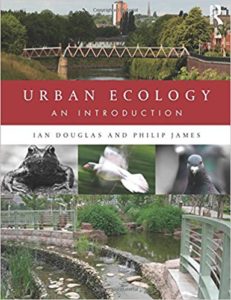 Urban Ecology: An Introduction seeks to open the reader’s mind and eyes to the way in which nature permeates everyday urban living, and how it has to be understood, cared for, and managed in order to make our towns and cities healthier places to visit and in which to live and work. The authors examine how nature can improve our physical and mental health, the air we breathe and the waters we use, as well as boosting our enjoyment of parks and gardens. Urban Ecology sets out the science that underlies the changing natural scene and the tools used to ensure that cities become both capable of adapting to climate change and more beautiful and resilient.
Urban Ecology: An Introduction seeks to open the reader’s mind and eyes to the way in which nature permeates everyday urban living, and how it has to be understood, cared for, and managed in order to make our towns and cities healthier places to visit and in which to live and work. The authors examine how nature can improve our physical and mental health, the air we breathe and the waters we use, as well as boosting our enjoyment of parks and gardens. Urban Ecology sets out the science that underlies the changing natural scene and the tools used to ensure that cities become both capable of adapting to climate change and more beautiful and resilient.
The book begins with a discussion of the nature of urban places and the role of nature in towns and cities. Part 1 looks at the context and content of urban ecology, its relationship to other foci of interest within ecology and other environmental sciences, and the character of city landscapes and ecosystems. In Part 2 the authors set out the physical and chemical components of urban ecosystems and ecological processes, including urban weather and climate, urban geomorphology and soils, urban hydrology and urban biogeochemical cycles. In Part 3 urban habitats, urban flora and fauna, and the effects of, deliberate and inadvertent human action on urban biota are examined. Part 4 contains an exploration of the identification and assessment of ecosystem services in urban areas, emphasising economic evaluation, the importance of urban nature for human health and well-being, and restoration ecology and creative conservation. Finally, in Part 5 the tasks for urban ecologists in optimising and sustaining urban ecosystems, providing for nature in cities, adapting to climate change and in developing the urban future in a more sustainable manner are set out.
Urban Ecology (Ecological Reviews), Kevin J. Gaston (editor). Routledge, March 2015.
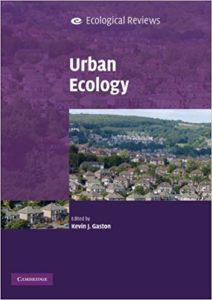 This is the urban century in which, for the first time, the majority of people live in towns and cities. Understanding how people influence, and are influenced by, the ‘green’ component of these environments is therefore of enormous significance. Providing an overview of the essentials of urban ecology, the book begins by covering the vital background concepts of the urbanisation process and the effect that it can have on ecosystem functions and services. Later sections are devoted to examining how species respond to urbanisation, the many facets of human-ecology interactions, and the issues surrounding urban planning and the provision of urban green spaces. Drawing on examples from urban settlements around the world, it highlights the progress to date in this burgeoning field, as well as the challenges that lie ahead.
This is the urban century in which, for the first time, the majority of people live in towns and cities. Understanding how people influence, and are influenced by, the ‘green’ component of these environments is therefore of enormous significance. Providing an overview of the essentials of urban ecology, the book begins by covering the vital background concepts of the urbanisation process and the effect that it can have on ecosystem functions and services. Later sections are devoted to examining how species respond to urbanisation, the many facets of human-ecology interactions, and the issues surrounding urban planning and the provision of urban green spaces. Drawing on examples from urban settlements around the world, it highlights the progress to date in this burgeoning field, as well as the challenges that lie ahead.
Urban Ecology: Patterns, Processes, and Applications, Niemela, Breuste, Guntenspergen, MyIntyre, Elmqvist, and James. Oxford University Press, January 2012.
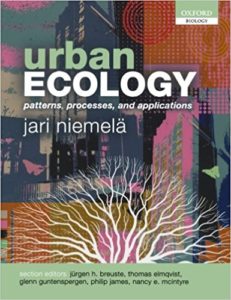 Urbanization is a global phenomenon that is increasingly challenging human society. It is therefore crucially important to ensure that the relentless expansion of cities and towns proceeds sustainably. Urban ecology, the interdisciplinary study of ecological patterns and processes in towns and cities, is a rapidly developing field that can provide a scientific basis for the informed decision-making and planning needed to create both viable and sustainable cities.
Urbanization is a global phenomenon that is increasingly challenging human society. It is therefore crucially important to ensure that the relentless expansion of cities and towns proceeds sustainably. Urban ecology, the interdisciplinary study of ecological patterns and processes in towns and cities, is a rapidly developing field that can provide a scientific basis for the informed decision-making and planning needed to create both viable and sustainable cities.
Urban Ecology brings together an international team of leading scientists to discuss our current understanding of all aspects of urban environments, from the biology of the organisms that inhabit them to the diversity of ecosystem services and human social issues encountered within urban landscapes. The book is divided into five sections with the first describing the physical urban environment. Subsequent sections examine ecological patterns and processes within the urban setting, followed by the integration of ecology with social issues. The book concludes with a discussion of the applications of urban ecology to land-use planning. The emphasis throughout is on what we actually know (as well as what we should know) about the complexities of social-ecological systems in urban areas, in order to develop urban ecology as a rigorous scientific discipline.
Urban Ecology: Science of Cities, 1st edition. Richard T.T. Forman. Cambridge Univ. Press, April 2014.
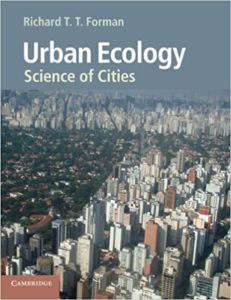 How does nature work in our human-created city, suburb, and exurb/peri-urb? Indeed how is ecology – including its urban water, soil, air, plant, and animal foundations – spatially entwined with this great human enterprise? And how can we improve urban areas for both nature and people? Urban Ecology: Science of Cities explores the entire urban area: from streets, lawns, and parks to riversides, sewer systems, and industrial sites. The book presents models, patterns, and examples from hundreds of cities worldwide. Numerous illustrations enrich the presentation. Cities are analyzed, not as ecologically bad or good, but as places with concentrated rather than dispersed people. Urban ecology principles, traditionally adapted from natural-area ecology, now increasingly emerge from the distinctive features of cities. Spatial patterns and flows, linking organisms, built structures, and the physical environment highlight a treasure chest of useful principles. This pioneering interdisciplinary book opens up frontiers of insight, as a valuable source and text for undergraduates, graduates, researchers, professionals, and others with a thirst for solutions to growing urban problems.
How does nature work in our human-created city, suburb, and exurb/peri-urb? Indeed how is ecology – including its urban water, soil, air, plant, and animal foundations – spatially entwined with this great human enterprise? And how can we improve urban areas for both nature and people? Urban Ecology: Science of Cities explores the entire urban area: from streets, lawns, and parks to riversides, sewer systems, and industrial sites. The book presents models, patterns, and examples from hundreds of cities worldwide. Numerous illustrations enrich the presentation. Cities are analyzed, not as ecologically bad or good, but as places with concentrated rather than dispersed people. Urban ecology principles, traditionally adapted from natural-area ecology, now increasingly emerge from the distinctive features of cities. Spatial patterns and flows, linking organisms, built structures, and the physical environment highlight a treasure chest of useful principles. This pioneering interdisciplinary book opens up frontiers of insight, as a valuable source and text for undergraduates, graduates, researchers, professionals, and others with a thirst for solutions to growing urban problems.
Urban Ecology: Strategies for Green Infrastructure and Land Use, Kimberly Etingoff, Apple Academic Press, July 2015
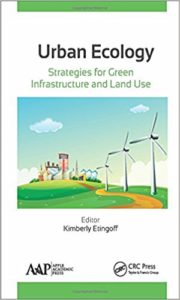 With increasing global urbanization, the environments and ecologies of cities are often perceived to suffer. While pollution and destruction of green space and species may occur, cities also remain part of natural systems. Cities provide natural processes necessary for survival for humans and other living organisms in urban areas. Urban ecology elucidates some of these processes and sheds light on their importance to healthy, fulfilling urban livelihoods.
With increasing global urbanization, the environments and ecologies of cities are often perceived to suffer. While pollution and destruction of green space and species may occur, cities also remain part of natural systems. Cities provide natural processes necessary for survival for humans and other living organisms in urban areas. Urban ecology elucidates some of these processes and sheds light on their importance to healthy, fulfilling urban livelihoods.
Urban Ecology: Strategies for Green Infrastructure and Land Use provides background on issues relating to urban ecology and urban natural processes. The first section covers the types, values, and recognition of ecosystem services provided by natural processes in urban areas. The second section details the importance and potential of green spaces in urban areas. The third section focuses on biodiversity traits of cities, and the ways in which urbanization affects biodiversity indicators. Finally, the fourth section covers some of the tools and approaches available for urban planners and designers concerned with improving or maintaining urban environments and the services they provide.
This easily accessible reference volume offers a comprehensive guide to this rapidly growing field. Case studies and up-to-date research provide urban planners with new options for creating cities that will meet the demands of the twenty-first century. Also appropriate for graduate students who are preparing for careers related to urban planning, this compendium captures and integrates the current work being done in this vitally important field.
Urban Ecosystems: Ecological Principles for the Built Environment, 1st edition. Frederick R. Adler and Colby J. Tanner. Cambridge Univ. Press, June 2013.
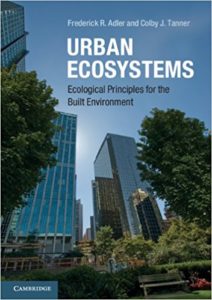 As humans have come to dominate the earth, the ideal of studying and teaching ecology in pristine ecosystems has become impossible to achieve. Our planet is now a mosaic of ecosystems ranging from the relatively undisturbed to the completely built, with the majority of people living in urban environments. This accessible introduction to the principles of urban ecology provides students with the tools they need to understand these increasingly important urban ecosystems. It builds upon the themes of habitat modification and resource use to demonstrate how multiple ecological processes interact in cities and how human activity initiates chains of unpredictable unintended ecological consequences. Broad principles are supported throughout by detailed examples from around the world and a comprehensive list of readings from the primary literature. Questions, exercises and laboratories at the end of each chapter encourage discussion, hands-on study, active learning, and engagement with the world outside the classroom window.
As humans have come to dominate the earth, the ideal of studying and teaching ecology in pristine ecosystems has become impossible to achieve. Our planet is now a mosaic of ecosystems ranging from the relatively undisturbed to the completely built, with the majority of people living in urban environments. This accessible introduction to the principles of urban ecology provides students with the tools they need to understand these increasingly important urban ecosystems. It builds upon the themes of habitat modification and resource use to demonstrate how multiple ecological processes interact in cities and how human activity initiates chains of unpredictable unintended ecological consequences. Broad principles are supported throughout by detailed examples from around the world and a comprehensive list of readings from the primary literature. Questions, exercises and laboratories at the end of each chapter encourage discussion, hands-on study, active learning, and engagement with the world outside the classroom window.
HEADER: Image via Cognitive Thinking Globe
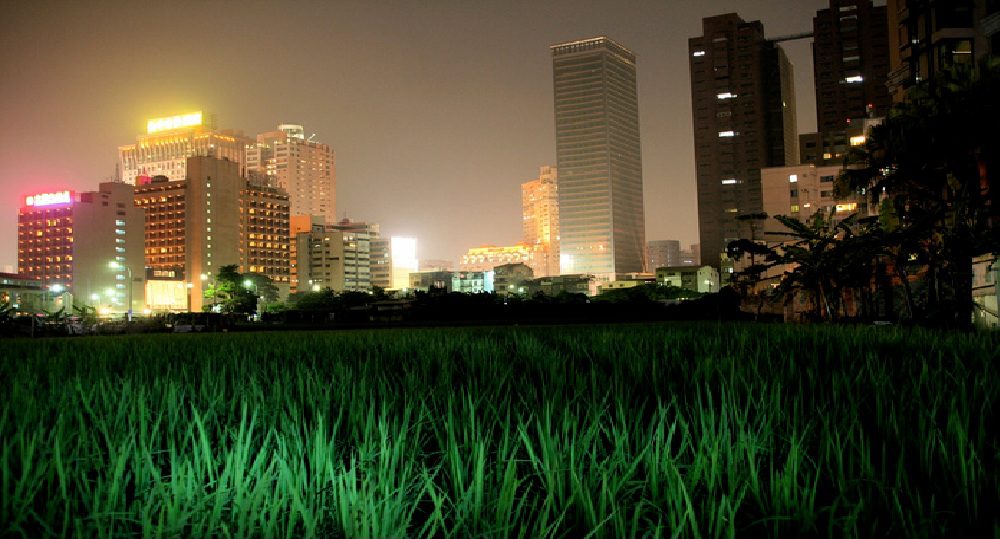
One thought on “Urban Ecology Reading List – Updated”